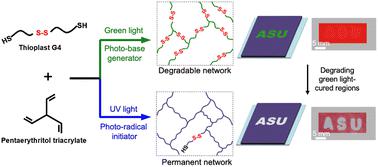当前位置:
X-MOL 学术
›
Polym. Chem.
›
论文详情
Our official English website, www.x-mol.net, welcomes your feedback! (Note: you will need to create a separate account there.)
Directing network degradability using wavelength-selective thiol-acrylate photopolymerization
Polymer Chemistry ( IF 4.6 ) Pub Date : 2024-02-12 , DOI: 10.1039/d3py01285a Saleh Alfarhan 1 , Jared Nettles 1, 2 , Parimal Prabhudesai 3 , Jen-Chieh Yu 1, 2 , Clarissa Westover 2, 4 , Tengteng Tang 3 , Wenbo Wang 5 , Xiangfan Chen 5 , Soyoung E. Seo 1, 2 , Xiangjia Li 3 , Timothy E. Long 1, 2, 6 , Kailong Jin 1, 2
Polymer Chemistry ( IF 4.6 ) Pub Date : 2024-02-12 , DOI: 10.1039/d3py01285a Saleh Alfarhan 1 , Jared Nettles 1, 2 , Parimal Prabhudesai 3 , Jen-Chieh Yu 1, 2 , Clarissa Westover 2, 4 , Tengteng Tang 3 , Wenbo Wang 5 , Xiangfan Chen 5 , Soyoung E. Seo 1, 2 , Xiangjia Li 3 , Timothy E. Long 1, 2, 6 , Kailong Jin 1, 2
Affiliation

|
Wavelength-selective photopolymerization employs light at controlled wavelengths to trigger orthogonal photochemical reactions to fabricate multimaterials with unique combinations of building blocks and material properties. Prior wavelength-selective photopolymerization studies mainly focused on modulating the thermomechanical properties of the resulting multimaterials, which are often permanently crosslinked, non-degradable polymer networks. Here, we combine wavelength-selective photopolymerization with dynamic covalent chemistry to fabricate multimaterials with programmable, stimuli-responsive degradability in selected regions. Specifically, this study employs a thiol-acrylate photoresin comprising both wavelength-selective photoinitiators/photosensitizers and dynamic disulfide bonds. Green light irradiation triggers photobase generators to catalyze the thiol-acrylate Michael addition reactions, forming a step-growth polymer network with dynamic disulfide bond-based crosslinks. This green light-cured network can subsequently undergo degradation/decrosslinking by reacting with excess reactive thiols through thiol-disulfide exchange reactions. Meanwhile, UV light irradiation cleaves radical photoinitiators and thus promotes both radical-mediated acrylate homopolymerization and thiol-acrylate addition reactions, forming a permanently crosslinked chain-growth network that cannot be degraded. Promisingly, this thiol-acrylate photoresin can undergo orthogonal wavelength-selective photopolymerization under patterned green- and UV-light irradiation to form crosslinked multimaterials with pre-designed degradable regions, which can be selectively removed to reveal the underlying photomasks’ patterns. Overall, the chemistry demonstrated herein can be used to fabricate complex patterns and hierarchical structures, holding promise for applications ranging from photolithography to 3D printing.
中文翻译:

使用波长选择性硫醇丙烯酸酯光聚合引导网络降解性
波长选择性光聚合利用受控波长的光来触发正交光化学反应,以制造具有独特的构建块和材料特性组合的多种材料。先前的波长选择性光聚合研究主要集中于调节所得多材料的热机械性能,这些材料通常是永久交联的、不可降解的聚合物网络。在这里,我们将波长选择性光聚合与动态共价化学相结合,制造出在选定区域具有可编程、刺激响应降解性的多种材料。具体来说,本研究采用包含波长选择性光引发剂/光敏剂和动态二硫键的硫醇丙烯酸酯光树脂。绿光照射触发光产碱剂催化硫醇-丙烯酸酯迈克尔加成反应,形成具有动态二硫键交联的逐步增长聚合物网络。这种绿光固化网络随后可以通过硫醇-二硫化物交换反应与过量的反应性硫醇发生降解/解交联。同时,紫外光照射会裂解自由基光引发剂,从而促进自由基介导的丙烯酸酯均聚和硫醇-丙烯酸酯加成反应,形成不可降解的永久交联链增长网络。这种硫醇丙烯酸酯光树脂可以在图案化的绿光和紫外光照射下进行正交波长选择性光聚合,形成具有预先设计的可降解区域的交联多材料,可以选择性地去除这些可降解区域以显示底层光掩模的图案。总体而言,本文演示的化学可用于制造复杂的图案和分层结构,有望应用于从光刻到 3D 打印的各种应用。
更新日期:2024-02-16
中文翻译:

使用波长选择性硫醇丙烯酸酯光聚合引导网络降解性
波长选择性光聚合利用受控波长的光来触发正交光化学反应,以制造具有独特的构建块和材料特性组合的多种材料。先前的波长选择性光聚合研究主要集中于调节所得多材料的热机械性能,这些材料通常是永久交联的、不可降解的聚合物网络。在这里,我们将波长选择性光聚合与动态共价化学相结合,制造出在选定区域具有可编程、刺激响应降解性的多种材料。具体来说,本研究采用包含波长选择性光引发剂/光敏剂和动态二硫键的硫醇丙烯酸酯光树脂。绿光照射触发光产碱剂催化硫醇-丙烯酸酯迈克尔加成反应,形成具有动态二硫键交联的逐步增长聚合物网络。这种绿光固化网络随后可以通过硫醇-二硫化物交换反应与过量的反应性硫醇发生降解/解交联。同时,紫外光照射会裂解自由基光引发剂,从而促进自由基介导的丙烯酸酯均聚和硫醇-丙烯酸酯加成反应,形成不可降解的永久交联链增长网络。这种硫醇丙烯酸酯光树脂可以在图案化的绿光和紫外光照射下进行正交波长选择性光聚合,形成具有预先设计的可降解区域的交联多材料,可以选择性地去除这些可降解区域以显示底层光掩模的图案。总体而言,本文演示的化学可用于制造复杂的图案和分层结构,有望应用于从光刻到 3D 打印的各种应用。



























 京公网安备 11010802027423号
京公网安备 11010802027423号